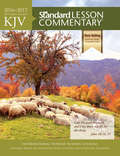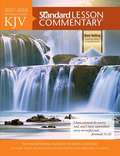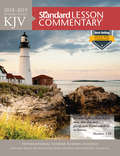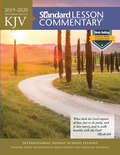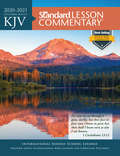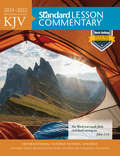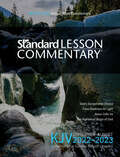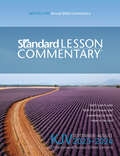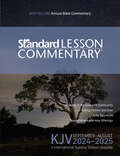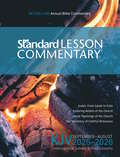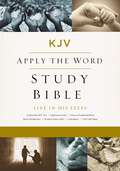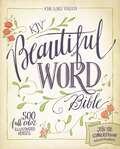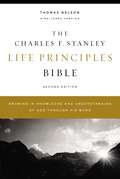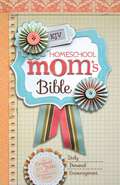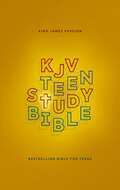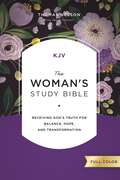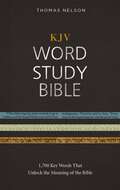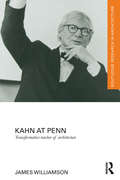- Table View
- List View
KJV Standard Lesson Commentary® 2016-2017
by Standard PublishingAs the nation's most popular annual Bible commentary for more than two decades, the Standard Lesson Commentary provides 52 weeks of study in a single volume and combines thorough Bible study with relevant examples and questions.The KJV SLC Paperback Edition is perfect as the primary resource for an adult Sunday school class and personal study or as a supplemental resource for any curriculum that follows the ISSL/Uniform Series.Nearly two dozen ministers, teachers, and Christian education specialists provide the Bible commentary, lesson plans, discussion questions, and other features that make the Standard Lesson Commentary the most popular annual Bible commentary available.The Standard Lesson Commentary is based on the popular Uniform Series, also called the International Sunday School Lessons. This series, developed by scholars from several church fellowships, provides an orderly study of the Bible in a 6-year period.
KJV Standard Lesson Commentary® 2017-2018
by Standard PublishingAs the nation's most popular annual Bible commentary for more than 2 decades, the Standard Lesson Commentary provides 52 weeks of study in a single volume and combines thorough Bible study with relevant examples and questions.The KJV SLC Paperback Edition is perfect as the primary resource for an adult Sunday school class and personal study or as a supplemental resource for any curriculum that follows the ISSL/Uniform Series.Nearly 2 dozen ministers, teachers, and Christian education specialists provide the Bible commentary, lesson plans, discussion questions, and other features that make the Standard Lesson Commentary the most popular annual Bible commentary available.The Standard Lesson Commentary is based on the popular Uniform Series, also called the International Sunday School Lessons. This series, developed by scholars from several church fellowships, provides an orderly study of the Bible in a 6-year period.
KJV Standard Lesson Commentary® 2018-2019 (Standard Lesson Comm)
by Standard PublishingThe KJV SLC is perfect as the primary resource for an adult Sunday school class and personal study or as a supplemental resource for any curriculum that follows the ISSL/Uniform Series Nearly two dozen ministers, teachers, and Christian education specialists provide the Bible commentary, lesson plans, discussion questions, and other features that make the StandardLesson Commentary the most popular annual Bible commentary available. The Standard Lesson Commentary is based on the popular Uniform Series, also called the International Sunday School Lessons. This series, developed by scholars from several church fellowships, provides an orderly study of the Bible in a 6-year period.
KJV Standard Lesson Commentary® 2019-2020 (Standard Lesson Comm)
by Standard PublishingKey features include:Printed ScriptureVerse-by-verse explanation of the Bible textDetailed lesson backgroundPronunciation guide for difficult wordsDiscussion startersA review quiz for each quarter The SLC, available in the King James Version and New International Version Bible translations, is based on the popular Uniform Series, also called the International Sunday School Lessons (ISSL). This series, developed by scholars from numerous church fellowships, outlines an in-depth study of the Bible over a six-year period. The four main themes of the 2019-2020 study are:Responding to God’s Grace—Pentateuch, 1 Samuel, 1 Kings, Luke, EpistlesHonoring God—1 Kings, 1 Chronicles, Matthew, LukeJustice and the Prophets—Esther, Prophets, 1 CorinthiansMany Faces of Wisdom—Proverbs, Ecclesiastes, Gospels, James SLC is perfect as the primary resource for an adult Sunday school class, personal study, or as a supplemental resource for any curriculum that follows the ISSL/Uniform Series. Nearly two dozen ministers, teachers, and Christian education specialists contribute their expertise to SLC, making it the most popular annual Bible commentary available.
KJV Standard Lesson Commentary® 2020-2021 (Standard Lesson Comm)
by Standard PublishingAs the world&’s most popular annual Bible commentary for more than two decades, Standard Lesson Commentary (SLC) provides 52 weeks of study in a single volume and combines thorough Bible study with relevant examples and questions. Key features include: Verse-by-verse explanation of the Bible TextDetailed lesson contextPronunciation guide for difficult wordsPrinted ScriptureDiscussion startersA review quiz for each quarter Available in the King James Version (KJV) and New International Version (NIV) Bible translations, the SLC is based on the popular Uniform Series. This series, developed by scholars from numerous church fellowships, outlines an in-depth study of the Bible over a six-year period. The four main themes of the 2020-2021 study are: Love for One Another—Genesis, 1 Samuel, Luke, John, Acts, 1 Corinthians, James, 1 JohnCall in the New Testament—Gospels, Acts, Romans, 1 Corinthians, HebrewsProphets Faithful to God&’s Covenant—Deuteronomy, Joshua, 1 & 2 Kings, Ezra, Nehemiah, Lamentations, ProphetsConfident Hope—Leviticus, Matthew, Luke, Romans, 2 Corinthians, Hebrews, 1 John The SLC is perfect as the primary resource for an adult Sunday school class, for personal study, or as a supplemental resource for any curriculum that follows the ISSL/Uniform Series. Nearly three dozen ministers, teachers, and Christian education specialists contribute their expertise to SLC. The Deluxe Edition features online and download access for the Standard Lesson eCommentary. Access is available through your choice of Logos Bible Software or Wordsearch Starter Engine. Both software options include the full text of the Standard Lesson Commentary (both KJV and NIV® editions) as well as: Full text of the KJV BibleFull-color visual resourcesStudent activity reproducible pagesQuarterly quizMore than a dozen additional helps and resource
KJV Standard Lesson Commentary® 2021-2022 (Standard Lesson Comm)
by Standard PublishingAs the world&’s most popular annual Bible commentary for more than two decades, Standard Lesson Commentary (SLC) provides 52 weeks of study in a single volume and combines thorough Bible study with relevant examples and questions. Key features include: Verse-by-verse explanation of the Bible textDetailed lesson contextPronunciation guide for difficult wordsPrinted ScriptureDiscussion startersA review quiz for each quarter Available in the King James Version (KJV) and New International Version® (NIV) Bible translations, the SLC is based on the popular Uniform Series. This series, developed by scholars from numerous church fellowships, outlines an in-depth study of the Bible over a six-year period. The four main themes of the 2021–2022 study are: Celebrating God—Exodus, 2 Samuel, Psalms, Mark, Acts, RevelationJustice, Law, History—Pentateuch, 2 Samuel, Ezra, Job, Isaiah, NahumGod Frees and Redeems—Deuteronomy, Ezra, Matthew, John, Romans, GalatiansPartners in a New Creation—Isaiah, John, Revelation The SLC is perfect as the primary resource for an adult Sunday School class, for personal study, or as a supplemental resource for any curriculum that follows the ISSL/Uniform Series. Nearly two dozen ministers, teachers, and Christian education specialists contribute their expertise to SLC. The Deluxe Edition features online and download access for the Standard Lesson eCommentary through FaithLife&’s Logos Bible Software. This includes the full text of the Standard Lesson Commentary (both KJV and NIV® editions) as well as: PowerPoint® presentationsFull text of the KJV BibleFull-color visual resourcesStudent activity reproducible pagesQuarterly quizMore than a dozen additional helps resources
KJV Standard Lesson Commentary® 2022-2023 (Standard Lesson Comm)
by Standard PublishingFor over twenty years, Standard Lesson Commentary (SLC) has been the most popular and trusted annual Bible commentary in the world. This nondenominational series provides 52 weeks of verse-by-verse commentary of Scripture, drawing you closer every day to God and His Word. With timely themes for your life, Standard Lesson Commentary 2022-2023 will help you study the Bible like never before. Key features include:Printed ScriptureDetailed lesson contextExpert verse-by-verse commentary of the Bible textPronunciation guide for difficult wordsThoughtful discussion startersA review quiz for each quarter Available in the King James Version (KJV) and New International Version® (NIV) Bible translations, the SLC is based on the popular Uniform Series. This series, developed by scholars from numerous church fellowships, outlines an in-depth study of the Bible over a six-year period. The four main themes of the 2022–2023 study are:God&’s Exceptional Choice—Genesis, Exodus, Deuteronomy, Judges, 1 Samuel, EphesiansFrom Darkness to Light—2 Chronicles, Isaiah, Joel, Luke, 1 Corinthians, 2 Timothy, James, 1 PeterJesus Calls Us—Matthew, Mark, Luke, John, ActsThe Righteous Reign of God—Isaiah, Ezekiel, Zephaniah, Zechariah, Matthew, Romans, Galatians, 1 Corinthians The SLC is perfect as the primary resource for an adult Sunday School class, for personal study, or as a supplemental resource for any curriculum that follows the ISSL/Uniform Series. Nearly two dozen ministers, teachers, and Christian education specialists contribute their expertise to SLC. The Deluxe Edition features online and downloadable access for the Standard Lesson eCommentary through FaithLife&’s Logos Bible Software. This includes the full text of the Standard Lesson Commentary (both KJV and NIV® editions) as well as: PowerPoint® presentationsFull text of the KJV BibleFull-color visual resourcesStudent activity reproducible pagesQuarterly quizMore than a dozen additional helps and resources
KJV Standard Lesson Commentary® 2023-2024 (Standard Lesson Comm)
by Standard PublishingAs the world&’s most popular annual Bible commentary for more than three decades, Standard Lesson Commentary (SLC) provides 52 weeks of study in a single volume and combines thorough Bible study with relevant examples and questions. Key features include:Verse-by-verse explanation of the Bible textDetailed lesson contextPronunciation guide for difficult wordsPrinted ScriptureDiscussion startersA review quiz for each quarter Available in the King James Version (KJV) and New International Version® (NIV) Bible translations, the SLC is based on the popular Uniform Series. This series, developed by scholars from numerous church fellowships, outlines an in-depth study of the Bible over a multi-year period. The four main themes of the 2023–2024 study are:God&’s Law Is Love—Luke, John, Acts, Romans, 1 Corinthians, Galatians, ColossiansFaith That Pleases God—Ruth, 1 Samuel, 2 Chronicles, Proverbs, Isaiah, Daniel, Habakkuk, Matthew, Luke, Romans, HebrewsExamining Our Faith—Matthew, Mark, Luke, Acts, Romans, 2 Corinthians, 1 Peter, JudeHope in the Lord—Acts, Romans, 2 Corinthians, Colossians, Hebrews, 1 Thessalonians, Titus, 1 John The SLC is perfect as the primary resource for an adult Sunday School class, for personal study, or as a supplemental resource for any curriculum that follows the ISSL/Uniform Series. Nearly two dozen ministers, teachers, and Christian education specialists contribute their expertise to SLC.
KJV Standard Lesson Commentary® 2024-2025 (Standard Lesson Comm)
by Standard PublishingAs the world&’s most popular annual Bible commentary for more than three decades, Standard Lesson Commentary (SLC) provides 53 weeks of study in a single volume and combines thorough Bible study with relevant examples and questions. Key features include: Verse-by-verse explanation of the Bible text Detailed lesson context Pronunciation guide for difficult words Printed Scripture Discussion starters A review quiz for each quarter Available in the King James Version (KJV) and New International Version® (NIV) Bible translations, the SLC is based on the popular Uniform Series. This series, developed by scholars from numerous church fellowships, outlines an in-depth study of the Bible over a multi-year period.The four main themes of the 2024–2025 study are:Worship in the Covenant Community—Genesis, Exodus, 2 Samuel, 1 Kings, 2 Kings, 2 Chronicles, Isaiah, Psalms, John A King Forever and Ever—Ruth, 2 Samuel, Psalms, Matthew, Luke Costly Sacrifice—Exodus, Leviticus, Numbers, Deuteronomy, 1 & 2 Chronicles, Ezra, Matthew, Hebrews, 1 John, Revelation Sacred Altars and Holy Gifts—Genesis, Matthew, Luke, John, Romans, 1 Corinthians, Ephesians, Hebrews, 1 Peter The SLC is perfect as the primary resource for an adult Sunday School class, for personal study, or as a supplemental resource for any curriculum that follows the ISSL/Uniform Series. Nearly two dozen ministers, teachers, and Christian education specialists contribute their expertise to SLC. The Deluxe Edition features online and downloadable access for the Standard Lesson eCommentary through FaithLife&’s Logos Bible Software. This includes the full text of the Standard Lesson Commentary (both KJV and NIV® editions) as well as: PowerPoint® presentations Full text of the KJV Bible Full-color visual resources Student activity reproducible pages Quarterly quiz More than a dozen additional helps and resources
KJV Standard Lesson Commentary® 2025-2026 (Standard Lesson Commentary)
by Standard PublishingAs the world&’s most popular annual Bible commentary for more than three decades, Standard Lesson Commentary (SLC) provides 52 weeks of study in a single volume. Designed for all types of Bible study, every lesson includes: Printed Scripture text in either KJV or NIV®Verse-by-verse commentary to explain and interpret Scripture Discussion questions to spark conversation and deeper reflection How to Say It pronunciation guide for biblical names and places Verbal illustrations that connect lesson themes to modern life Learning activities to encourage life application This Quarter in the Word daily Bible readings to encourage study throughout the week A quarterly review quiz to test comprehension of Scripture Free reproducible student activity pages and other helpful resources for each lesson Trusted for over 60 years, this verse-by-verse commentary will guide you in an in-depth study of the Bible. Following the International Sunday School Lessons (ISSL)/Uniform Series, Standard Lesson explores new topics every year.Deepen your understanding of Scripture in 2025–2026 with these areas of study:Judah, From Isaiah to the Exile—Isaiah, 2 Chronicles, Jeremiah, 2 Kings, Ezekiel This section invites us to discover and appreciate how God, through prophets and other leaders, gave help and guidance to the people of Judah. As we study these people, we will see God&’s hand at work in their lives, just as he is at work in our lives and all human affairs. Enduring Beliefs of the Christian Faith—Exodus, Psalms, The Gospels, Acts, Romans, 1 and 2 Corinthians, Ephesians, 2 Timothy, 1 John, Revelation This section encourages us to meditate on the fundamental beliefs of the Christian faith. This study will show us that God has revealed his grace and mercy. As a result, God&’s people are called to live by his standard—a standard that is often countercultural. Social Teachings of the Church—Genesis, Exodus, Deuteronomy, Nehemiah, Isaiah, Daniel, Jonah, Psalms, The Gospels, Acts, Romans, 1 Corinthians, Galatians, Ephesians, Hebrews, 1 Timothy, 2 Thessalonians, James This section contemplates a kingdom perspective regarding our responsibilities, relationships, and commitments. God instructs his people to relate in particular ways to their friends, neighbors, family, governmental structures, and even the structured rhythm of our days. He cares about how we treat our bodies, what we consume, and how we use our time. The Testimony of Faithful Witnesses—Judges, 1 Samuel, Amos, The Gospels, Acts, 2 Timothy, Philemon This section looks at the examples of faithful witnesses from Scripture. These were people who heard the call of God, responded in faith, and testified to God&’s mercy and fidelity to his promises through their words and deeds. Available in the King James Version (KJV) and New International Version® (NIV) Bible translations, the SLC is developed by scholars from numerous church fellowships and outlines an in-depth study of the Bible.
KJV, Apply the Word Study Bible, Ebook, Red Letter Edition: Live in His Steps
by Thomas NelsonThe Apply the Word Study Bible brings you to an intimate understanding of the Bible's message, helps you think about it and apply it to your lives. People of all ages and walks of life will enjoy the fresh style of the feature articles, which are directed at helping you approach life with the mind of Christ. You will discover that the Bible is a very practical book, just what is needed to guide you through every day. Featuring abundant sidebar articles and vibrant full-color design, the Apply the Word Study Bible is the perfect companion for everyday living. Features include: Now available in the beloved King James Version Large easy-to-read type Words of Jesus in red Hundreds of sidebar articles for seeing the relevance of Scripture for everyday living Insightful introductions to the books of the Bible Informative notes about people and places of Bible times Full-color page design provides a helpful and interesting visual encounter with Scripture Charts, tables and maps provide abundant Bible information Concordance for helpful reference Full-color maps to illustrate the Bible lands
KJV, Beautiful Word Bible, eBook: 500 Full-Color Illustrated Verses (Beautiful Word)
by ZondervanBe drawn into God’s Word through a fresh, creative expression of the beautiful words of God. The KJV Beautiful WordTM Bible will encourage a deeper and more authentic quiet time. With 500 verses illustrated to help you see the rich diversity of stories, characters, prophecies, rewards, and hope contained within Scripture, you will discover wisdom to sustain you in every season, drawing you deeper into God’s life-changing and inspired Word.Features include:Full text of the King James Version (KJV)Words of Christ in red500 full-color illustrated versesIndex of illustrated Scripture passages
KJV, Charles F. Stanley Life Principles Bible, 2nd Edition, eBook: Growing in Knowledge and Understanding of God Through His Word
by Thomas NelsonThe Charles F. Stanley Life Principles Bible is designed to lead believers into a life-changing relationship with Jesus Christ, and to help them experience the Good News about God&’s mighty kindness and love. Built around 30 Life Principles Dr. Stanley has gleaned from Scripture during his fifty years of teaching and pastoral ministry, this Bible is sure to encourage and strengthen believers as they seek to lead faithful, joyful lives that please God.With over one million Life Principles Bibles sold to date, the updated second edition is the best way to experience this bestselling classic—with a completely new design featuring Thomas Nelson&’s KJV easy-to-read Comfort Print® typeface, 100 specially designed maps and charts that bring biblical places and themes to life, and over 43,000 cross references to enrich your study of the Word.Features include:30 Life Principles articles highlight Dr. Stanley&’s essentials for Christian livingMore than 2,500 Life Lessons verse notes bring to life the practical and personal nature of God&’s Word to usLife Examples articles draw powerful lessons from the lives of people throughout ScriptureOver 300 highlighted verses make it easy to find God&’s promises throughout the Bible text that encourage, strengthen, and bring hopeAnswers to Life's Questions and What the Bible Says About articles bring scriptural insight to bear on topics of special importance to every believerTopical indexes give immediate access to hundreds of life-giving principles and promises throughout the Old and New TestamentsBook introductions provide an overview of the themes and literary structure of each book, and alert readers to important principles they&’ll encounter as they readNew for the 2nd Edition, 100 maps and charts that help important biblical places and themes come alive, and over 43,000 cross references to enrich your studyConcordance
KJV, Homeschool Mom's Bible
by ZondervanHeartfelt Inspiration to Revive, Encourage, and Strengthen the Homeschooling MomIf you&’re on an airplane, you&’re instructed, in the event of a loss of cabin pressure, to put on your own oxygen mask before helping your child. The reason? If you don&’t have a supply of oxygen, you won&’t be able to help anyone else.The same is true for the rest of life: you can&’t give what you don&’t have. And as a homeschooling mom, you pour yourself out every day for the sake of your children. Yet how do you fill yourself up? Where do you get your spiritual oxygen?Now you can be filled and restored by the original Bible for homeschool moms—with a full year&’s worth of encouraging daily devotions placed alongside the beloved text of the King James Bible. These heartfelt, practical readings written by Janet Tatman, a former homeschooling mom, cover topics such as finding strength to keep motivated, avoiding burnout, staying focused and committed, navigating the needs of toddlers while educating siblings, managing schedules, delegating tasks and chores, setting boundaries, and most importantly, maintaining proper soul care while juggling educational and household responsibilities.The words of these devotions will breathe life into your soul so that you can successfully run the race. Features:• 365 daily meditations with prayers written by Janet Tatman, a veteran homeschooling mother with more than 25 years of experience homeschooling • The full text of the classic King James Version (KJV) Bible • Foreword from Vickie Farris, author, homeschool mom, and wife of Michael Farris, founder of the Homeschool Legal Defense Association• Topical index
KJV, Know The Word Study Bible, Ebook, Red Letter Edition: Gain a greater understanding of the Bible book by book, verse by verse, or topic by topic
by Thomas NelsonThe KJV Know the Word Study Bible offers three easy ways to begin studying Scripture and helps individuals transition from being a casual reader of the Bible to becoming a regular student of the Bible. You can choose to study the Bible book-by-book, verse-by-verse, or topic-by-topic; each path offers powerful insights that will help you develop a daily routine of Bible study. The book-by-book series of notes leads you through the main points of each book of the Bible. The verse-by-verse notes help you to dig deeper into God’s Word. The topic-by-topic articles, which cover 21 theological topics, guide you through a series of insightful notes and give you a thorough biblical understanding of each topic. With the beautiful and timeless text of the KJV translation, the KJV Know the Word Study Bible offers you choices of how to study Scripture and grow in your relationship with Christ.Features Include: • King James Version Bible text• Three easy approaches to study the Bible: 1. Book by Book; 2. Verse by Verse; 3. Topic by Topic• Insightful introductions for each book of Scripture• Words of Jesus in red• Beautiful two-color interior page design• Comprehensive list of theological notes• Concordance• Full-color maps
KJV, Teen Study Bible
by ZondervanThe bestselling KJV Teen Study Bible helps teens apply God&’s Word to the issues they face every day!Full of study features to help today's teen learn more about God, the Bible, and how God's Word relates to their lives, the KJV Teen Study Bible will help them keep in step with all God has done, is doing, and will do in the world. Teens will discover the eternal truths of God's Word and how to apply them to the issues they face every day as they read biblical advice about dealing with everything from friends, family, and school to problems such as bullying and depression. As teens navigate their hectic and sometimes stressful lives, this study Bible will help them to deepen and understand their faith while reassuring them that God is always with them, and they are never alone.Features:Complete text of the King James Version (KJV)&“We Believe&” features unpack the Apostles&’ Creed to reveal the biblical foundation of faith&“Panorama&” features keep the big picture of each book of the Bible in viewTopical indexes help with in-depth Bible studyBook introductions provide an overview for each book of the BibleBiblical advice about friends, family, school, and other issuesImportant Bible verses to memorizeQ and As test your Bible knowledgeProfiles of people in the BibleTwo-color page design8-page full-color map section
KJV, The Woman's Study Bible, Full-Color, Comfort Print: Receiving God's Truth for Balance, Hope, and Transformation
by Thomas NelsonA study Bible with thousands of verse commentary notes designed by women specifically for women to receive God&’s truth for balance, hope, and transformation.The Woman&’s Study Bible poignantly reveals the Word of God to women, inviting them to receive God&’s truth for balance, hope, and transformation. Special features designed to speak to a woman&’s heart appear throughout the Bible text, revealing Scripture-based insights about how godly womanhood grows from a woman&’s identity as a Christ-follower and a child of the kingdom.Now with a beautiful full-color redesign, The Woman&’s Study Bible reflects the contributions of over 80 women from a wide variety of ethnic, denominational, educational, and occupational backgrounds. Since the publication of the first edition of The Woman&’s Study Bible, this landmark study Bible has sold over 2 million copies. Features include: Beautiful full-color design throughout for you to enjoy as you engage ScriptureDetailed biographical portraits allow you to learn from the lives of over 100 women in the BibleThousands of extensive verse-by-verse study notes explain each passage and provide meaning to ScriptureOver 300 in-text topical articles on relevant issues for you to glean wisdom from and apply to your lifeInsightful essays by women who are recognized experts in the fields of theology, biblical studies, archaeology, and philosophy to deepen your theological knowledgeBook introductions and outlines provide an overview and context for each bookHundreds of full-color, in-text maps, charts, timelines, and family trees give a visual representation of Israel and other biblical themesQuotes from godly women throughout history to encourage and guide your faith journeyTopical index and concordance help locate words and show the number of occurrences throughout the BibleClear and readable KJV Comfort Print® typeface in 10.5-point print size
KJV, Word Study Bible, Ebook, Red Letter Edition: 1,700 Key Words that Unlock the Meaning of the Bible
by Thomas NelsonThe KJV Word Study Bible provides 1,700 easy-to-use word studies, in-text subheadings, select Hebrew, Aramaic and Greek words explained from Genesis to Revelation helping you dig deeper into your Bible study. By relying on these ancient texts we are able to read scripture as it was originally written and passed on from generation to generation, bringing these words to life allowing you to almost hear Jesus teaching on the hillside or crying out to God on the cross. As you study you will discover the richness and significance of the original languages of the Word of God and experience scripture in a whole new way. Features Include: • Book introductions • Words of Christ in red • Word studies • Indexes • Concordance
KRITIKA Bhag 1
by National Council Of Educational Research TrainingThis book prescribed by central board of secondary education, India for the students of class 9th subject Hindi, studying through hindi medium. This accessible version of the book doesn’t leave any part of the book. The book is handy companion of the school and university students desiring to read facts in interesting way. NCERT books are must read for aspirants of competitive and job related examinations in India.
KRITIKA Bhag 2
by National Council Of Educational Research TrainingThis book prescribed by central board of secondary education, India for the students of class 10th subject Hindi, studying through hindi medium. This accessible version of the book doesn’t leave any part of the book. The book is handy companion of the school and university students desiring to read facts in interesting way. NCERT books are must read for aspirants of competitive and job related examinations in India.
Kabeer (Kabeer Ke Vyaktitva, Sahitya Aur Darshanik Vicharonki Aalochana) – Ranchi University N.P.U: कबीर (कबीर के व्यक्तित्व, साहित्य और दार्शनिक विचारों की आलोचना) - रांची युनिवर्सिटी, एन.पि.यू.
by Hazari Prasad Dwivediकबीर (कबीर के व्यक्तित्व, साहित्य और दार्शनिक विचारों की आलोचना) यह पुस्तक राजकमल प्रकाशन ने हिंदी भाषा में प्रकाशित किया है, इस पुस्तक में कबीरदास जिस सहज-समाधि की बात कहते हैं वह योगमार्ग से असम्मत नहीं है। यहाँ यह भी कह रखना जरूरी है कि पुस्तक में भिन्न-भिन्न साधन-मार्गों के ऐतिहासिक विकास की ओर ही अधिक ध्यान दिया गया है। पुस्तक के अंत में उपयोगी समझकर ‘कबीर-वाणी’ नाम से कुछ चुने हुए पद्य संग्रह किए गए हैं। उनके शुरू के सौ पद श्री आचार्य क्षितिमोहन सेन के संग्रह के हैं। पुस्तक के इस संस्करण में यथासंभव संशोधन किया गया है। पुस्तक लंबी प्रतीक्षा के उपरांत पाठकों के समक्ष आ रही है।
Kagan Cooperative Learning
by Miguel KaganThis new book presents today's most successful cooperative learning methods. The Kagans make it easier than ever to boost engagement and achievement. You'll still find all the practical and proven Kagan Structures, including Numbered Heads Together, RoundTable, and Three-Step Interview—direct from the man who invented cooperative learning structures. And there's still plenty of ready-to-do teambuilding and classbuilding activities to make your class click. But in this expanded edition, you will find new step-by-step structures, hundreds of helpful management tips, many more teacher-friendly activities and forms, and up-to-date research on proven methods. You hear how schools have used Kagan Cooperative Learning to boost academics, close the achievement gap, improve student relations, and create a more kind and caring school community. After decades of training and working with hundreds of thousands of teachers, Kagan has refined and perfected the most widely used and respected form of cooperative learning ever. The Kagans make it easy for you to dramatically increase engagement and achievement in your class!.
Kahn at Penn: Transformative Teacher of Architecture (Routledge Research in Architecture)
by James WilliamsonLouis I. Kahn is widely known as an architect of powerful buildings. But although much has been said about his buildings, almost nothing has been written about Kahn as an unconventional teacher and philosopher whose influence on his students was far-reaching. Teaching was vitally important for Kahn, and through his Master’s Class at the University of Pennsylvania, he exerted a significant effect on the future course of architectural practice and education. This book is a critical, in-depth study of Kahn’s philosophy of education and his unique pedagogy. It is the first extensive and comprehensive investigation of the Kahn Master’s Class as seen through the eyes of his graduate students at Penn.
Kalarav class 1 - GSTB: કલરવ ધોરણ 1 (પાઠ્યપુસ્તક ) - જીએસટીબી
by Prakash Bhatti Shri Ramesh Chandra Thakkar Shri Goswami Minesh Varand Harshvi Patપ્રસ્તુત પાઠ્યપુસ્તક તેનાં ચતુરંગી સ્વરૂપ દ્વારા બાળકો હોંશે-હોંશે તેનો ઉપયોગ કરે અને ભાષા-પર્યાવરણની અધ્યયન નિષ્પત્તિઓ સાર્થક કરે તે લક્ષિત છે. પ્રસ્તુત પાઠ્યપુસ્તક ધોરણ ૧ ના ગુજરાતી (કલરવ)વિષય નું છે. જેમાં રોચક ૧૦ પાઠ આપેલ છે.
